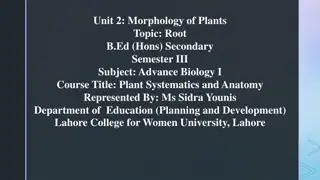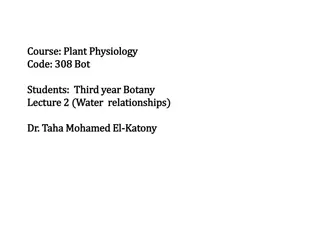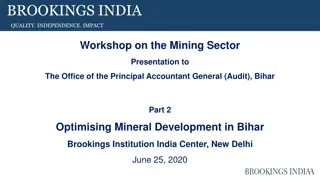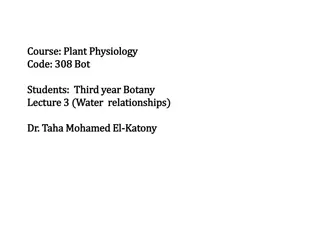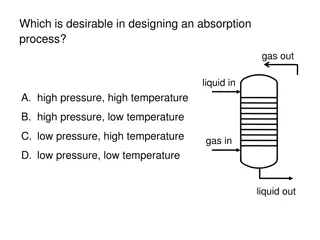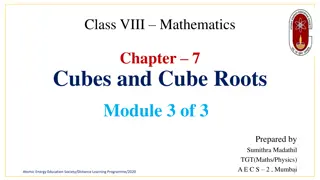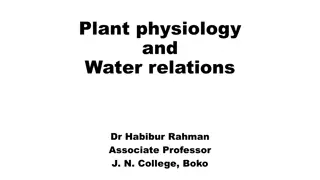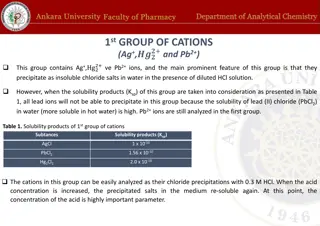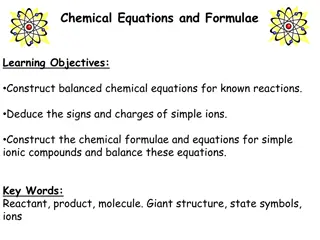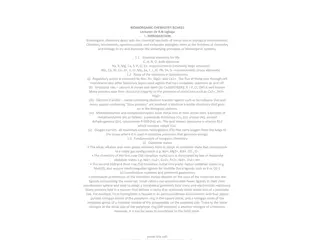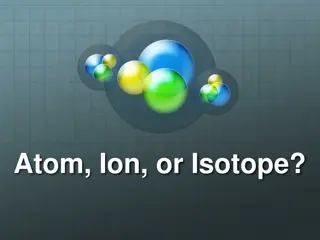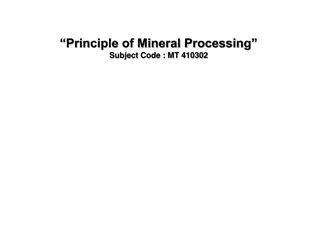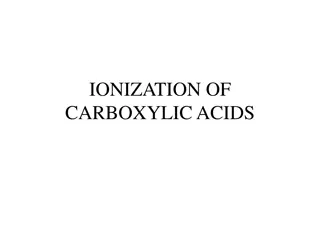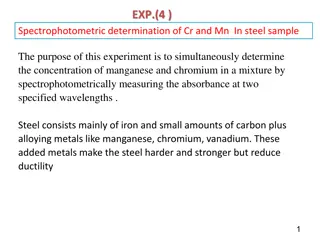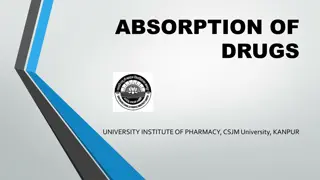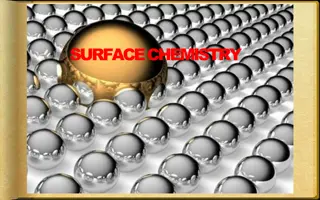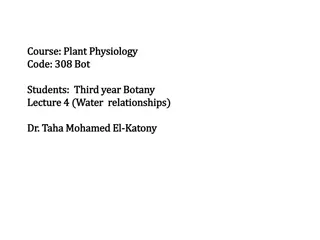Plant Mineral Nutrition: Absorption and Circulation of Ions in Roots
Plant mineral nutrition involves the absorption and translocation of ions across roots. Salts are absorbed passively and actively, with ions moving into the root's apoplasm via free diffusion. The Casparian strip in endodermal cells acts as a barrier, allowing ions to pass only through the protoplast. Once absorbed, ions are delivered into the xylem for circulation throughout the plant, where they are essential for various metabolic processes.
Download Presentation

Please find below an Image/Link to download the presentation.
The content on the website is provided AS IS for your information and personal use only. It may not be sold, licensed, or shared on other websites without obtaining consent from the author. Download presentation by click this link. If you encounter any issues during the download, it is possible that the publisher has removed the file from their server.
E N D
Presentation Transcript
Course: Plant Physiology Course: Plant Physiology Code: Code: 308 308 Bot Bot Students: Third year Botany Students: Third year Botany Lecture Lecture 2 2 (Plant Mineral Nutrition) (Plant Mineral Nutrition) Dr. Dr. Taha Taha Mohamed El Mohamed El- -Katony Katony
Absorption and translocation Absorption and translocation The path of ions across the root The path of ions across the root Absorption of salts by roots is both passive and active. Absorption of salts by roots is both passive and active. The movement of ions into the AFS ( The movement of ions into the AFS (apoplasm (by free diffusion). (by free diffusion). apoplasm) is passive ) is passive Ions can move freely in the Ions can move freely in the wet cell walls ( the r the root as far as the endodermis. oot as far as the endodermis. wet cell walls (apoplast apoplast) of ) of Further penetration is retarded by the Further penetration is retarded by the C Casparian asparian strip. strip. The The continuum continuum palsmodesmata palsmodesmata is called the of of is called the symplast cytoplasm cytoplasm and and the the connecting connecting symplast. .
The endodermal cells by virtue of the The endodermal cells by virtue of the Casparian present a barrier to the passive diffusion of ions. present a barrier to the passive diffusion of ions. Casparian strip strip The protoplast of endodermal cells is tightly attached to The protoplast of endodermal cells is tightly attached to the the Casparian Casparian strip. strip. Ions Ions can cells cells. . can not not pass pass through through the the walls walls of of the the endodermal endodermal The The only only route route available available is is through through the the protoplast protoplast. .
How How can can ions ions be be delivered delivered into into xylem? xylem? It It was was supposed supposed that increasing increasing CO that there there is is a a gradient CO2 2 levels levels from from the gradient of of decreasing the cortex cortex to to the decreasing O O2 2 and the stele stele. . and The The living living cells low low metabolic metabolic activity, lumen lumen of of xylem cells adjacent adjacent to to the the xylem xylem vessels activity, are are leaky xylem vessels vessels. . vessels therefore therefore possess leaky and and lose lose salts possess salts to to the the Diffusion Diffusion of of salts is is not not allowed into into the the lumina salts back allowed and lumina of of the back through through the and there there is is a a unidirectional the xylem xylem vessels the impervious impervious Casparian unidirectional loss vessels. . Casparian strip loss of of salt strip salt
Circulation of salts Circulation of salts Salts delivered to the xylem ducts of the root are Salts delivered to the xylem ducts of the root are translocated upward to the shoot and, once there, are distributed upward to the shoot and, once there, are distributed and redistributed throughout the plant. and redistributed throughout the plant. translocated Salts deposited in the leaves are withdrawn prior to Salts deposited in the leaves are withdrawn prior to abscission and abscission and translocated translocated to the reproductive organs or to the reproductive organs or younger leaves. younger leaves. Circulation takes place in the vascular tissues. Circulation takes place in the vascular tissues.
By the use of radioactive tracers several pathways for the By the use of radioactive tracers several pathways for the translocation of salts were discovered: translocation of salts were discovered: 1 1- - in the xylem, in the xylem, 2 2- - in the phloem, in the phloem, 3 3- - laterally between the two tissues and laterally between the two tissues and 4 4- - outward from the leaves. outward from the leaves.
Translocation of salts in xylem Translocation of salts in xylem Experimental evidence Experimental evidence 1- Ringing experiment: The upward translocation of salts is unimpeded by removal of a ring of phloem near the stem base. 2- Large amounts of salts occur in the xylem sap. 3- 32P travels upward to plant tip faster under high transpiration (bright sunlight) than under low transpiration. 4- If transpiration by a leaf is diminished by covering the leaf with a polyethylene bag, translocation of minerals to that particular leaf is reduced considerably.
5 5- - Dissection Dissection experiment experiment with with radioactive radioactive tracers tracers: : A A: : Procedure Procedure i i- - The The bark were were separated was was inserted inserted between bark and separated and and xylem xylem along along a a 9 9- -inch and a a strip strip of of impervious between them them. . inch length length of of a a willow impervious waxed willow stem waxed paper stem paper iii iii- - The The continuity continuity of of bark the the plant plant was bark and left intact intact. . and xylem xylem was was undisturbed, undisturbed, and and was left absorb 42 42K K for iv iv- - The The plant plant was was allowed allowed to to absorb for 5 5 hours hours. . v v- - Sections Sections of of the analyzed analyzed for the treated treated and for 42 and intact intact areas areas of of the the stem stem were were 42K K. .
Stripped branch 42K in bark (ppm) Unstripped branch 42K in bark (ppm) 42K in wood (ppm) 42K in wood (ppm) Section SA 53.0 47 64 56 S6 11.6 119 S5 0.9 122 S4 0.7 112 87 69 S3 0.3 98 S2 0.3 108 S1 20.0 113 SB 84.0 58 74 67
B: Results and conclusion B: Results and conclusion 1- 42K translocates upward in the xylem. 2- Lateral interchange of 42K between phloem and xylem (through cambium) occurs within the intact region but further translocation either upward or downward in the phloem is slow. 3- The small amounts of 42K in the bark along the stripped area suggests that little translocation takes place in the phloem tissue.
Lateral translocation of salts Lateral translocation of salts T The above experiment revealed: he above experiment revealed: 1 1- - upward translocation of salts in xylem upward translocation of salts in xylem and and 2 2- - lateral movement between xylem and phloem through lateral movement between xylem and phloem through cambium. cambium. Cambium regulates the amount of salts carried up in the Cambium regulates the amount of salts carried up in the transpiration stream. transpiration stream. If the upward movement of salts were not regulated, certain If the upward movement of salts were not regulated, certain areas of the plant areas of the plant (shoot and root tips) would (shoot and root tips) would not be accommodated. accommodated. not be The cambium position allows The cambium position allows - - both physically physically - - re regulation of the upward, lateral and gulation of the upward, lateral and downward movement of salt. downward movement of salt. both metabolically metabolically and and
The active accumulation of salt by the cambial cells acts The active accumulation of salt by the cambial cells acts as a deterrent against an indiscriminate sweep of as a deterrent against an indiscriminate sweep of salts upward in the transpiration stream. salts upward in the transpiration stream. The lateral movement from xylem to phloem correlates The lateral movement from xylem to phloem correlates inversely with element content in the phloem inversely with element content in the phloem high concentration of an element in the phloem, slows high concentration of an element in the phloem, slows down the lateral translocation into the phloem and down the lateral translocation into the phloem and low concentration enhances lateral movement. low concentration enhances lateral movement.
Translocation of salts in the phloem Translocation of salts in the phloem The initial upward movement of salts occurs in the xylem. The initial upward movement of salts occurs in the xylem. But upward movement may occur also in the phloem. But upward movement may occur also in the phloem. Evidence on upward movement: Evidence on upward movement: 1 1- - Ringing bark high up in the stem Ringing bark high up in the stem retarded s retarded stem tip growth. tem tip growth. But ringing at stem base has no effect on salt nutrition of the whole But ringing at stem base has no effect on salt nutrition of the whole plant including stem tip. plant including stem tip. Thus, the influence on stem tip growth was because of the blockage Thus, the influence on stem tip growth was because of the blockage of salts moving out of the lower leaves and transported upward in of salts moving out of the lower leaves and transported upward in the phloem and not because of the root the phloem and not because of the root- -absorbed salts. absorbed salts.
Evidence on downward movement: Evidence on downward movement: 2 2- - Dissection experiment with Radioactive tracers. Dissection experiment with Radioactive tracers. Procedure Procedure: : A A- - The bark was separated from wood by waxed paper The bark was separated from wood by waxed paper immediately below leaf petiole of a cotton plant. immediately below leaf petiole of a cotton plant. B B- - Bark and wood were left intact. Bark and wood were left intact. 32 32P was injected into leaf blade just above the P was injected into leaf blade just above the separated area. separated area. C C- - D D- - One hour One hour later, sections of stem were analyzed for later, sections of stem were analyzed for 32 32P. P.
Stripped plant 32P in bark (mg) Unstripped plant 32P in bark (mg) 32P in wood (mg) 32P in wood (mg) Section A 1.11 0.444 I 0.485 0.100 C 0.610 S1 0.554 0.064 0.160 0.055 S2 0.332 0.004 0.103 0.063 S3 0.592 000 0.055 0.018 S4 0.228 0.004 0.026 0.007 0.152 B 0.653
Results and conclusion Results and conclusion 1 1- - Salts Salts entering primarily primarily in in a a downward the the phloem phloem. . entering the the main main vascular downward as vascular stream as well well as stream from as upward upward direction from leaf direction in in leaf move move 2 2- - Lateral Lateral transport where where the transport between the phloem phloem and between the and xylem the vascular vascular tissues xylem are are not not separated tissues takes separated. . takes place place 4 4- - Both Both tissues translocation translocation of of mineral tissues may may thus mineral salts thus be be involved involved with salts moving moving out with the out from from leaves the upward upward leaves. .
The movement of salts in the phloem is bidirectional. The movement of salts in the phloem is bidirectional. This bidirectional movement might occur: This bidirectional movement might occur: 1 1- - Simultaneously in the same sieve elements. Simultaneously in the same sieve elements. Or Or 2 2- - In two different phloem channels, one toward the In two different phloem channels, one toward the tip and the other toward the base of the plant. tip and the other toward the base of the plant.
Outward movement of salts from leaves Outward movement of salts from leaves In In the the leaves leaf leaf just leaves of of deciduous deciduous plants, just prior prior to to abscission plants, mineral mineral salts abscission. . salts move move out out of of the the The The mineral mineral nutrients Cl Cl and and (Mg nutrients moving (Mg and and Fe) moving out Fe). . out of of leaves leaves are are N, N, K, K, P, P, S, S, Those Those remaining remaining include include Ca Ca, , B, B, Mn Mn and and Si Si. . Mineral Mineral nutrients nutrients move move out out of of leaves leaves primarily primarily in in the the phloem phloem. . When When 32 32P P was plant plant: : P P from while while P P from was introduced introduced to to leaves from base base leaves leaves moves from top top leaves leaves moves leaves at at different moves downward downward toward moves upward upward to to tip different levels toward the tip. . levels on on the the the root root
Circulation and reutilization Circulation and reutilization Minerals Minerals are are taken taken up up in in the the transpiration transpiration stream stream. . Move Move primarily primarily in in the the xylem xylem vessels vessels to to the the leaves leaves. . Excess Excess quantities quantities are translocated translocated downward are withdrawn withdrawn from downward in in the from leaves phloem. . leaves and and re re- - the phloem Then Then they upward upward translocation they could could be be laterally laterally transported transported into translocation could could take into the place again the xylem xylem w where again. . here take place Elements Elements such such as as N, N, K K and and P P move move readily readily in in this this circuit circuit. . Calcium Calcium ascends ascends the the stem stem but but does does not not relocate relocate in in the the phloem phloem. .
Phosphorus Phosphorus P is highly mobile in the plant and it is in continuous P is highly mobile in the plant and it is in continuous circulation. circulation. P mobility is an essential feature of plant growth. P mobility is an essential feature of plant growth. P is needed in such metabolic schemes as photosynthesis, P is needed in such metabolic schemes as photosynthesis, starch synthesis, glycolysis, and the synthesis of fats and starch synthesis, glycolysis, and the synthesis of fats and proteins. proteins. P is thus needed at various points in the plant. P is thus needed at various points in the plant. A pool of P in a useable form is maintained throughout the A pool of P in a useable form is maintained throughout the plant in a relatively uniform concentration. plant in a relatively uniform concentration.
Sulfur Sulfur Sulfur is mobile in plants but to a lower extent than P. Sulfur is mobile in plants but to a lower extent than P. This is because of its rapid incorporation into metabolic This is because of its rapid incorporation into metabolic compounds. compounds. Absorbed *S rapidly ascends in the xylem to the leaves. Absorbed *S rapidly ascends in the xylem to the leaves. Within 24 h most of the *S was found in the younger leaves. Within 24 h most of the *S was found in the younger leaves. The older leaves having lost their S to the young actively The older leaves having lost their S to the young actively growing leaves. growing leaves. S is a constituent of protein and protein synthesis occurs S is a constituent of protein and protein synthesis occurs heavily in the younger leaves. heavily in the younger leaves. S, then, is freely mobile in the plant but is rendered S, then, is freely mobile in the plant but is rendered immobile rather quickly in metabolic reactions. immobile rather quickly in metabolic reactions.
Iron Iron Mobility of iron in the plant depends on : Mobility of iron in the plant depends on : 1 1- - Fe concentration of the plant tissues. Fe concentration of the plant tissues. Being highest at low Fe concentration in the plant and Being highest at low Fe concentration in the plant and decreases at high concentration. decreases at high concentration. 2 2- - P availability. P availability. High P concentrations in the plant tissues render iron High P concentrations in the plant tissues render iron immobile in the veins of the leaf. immobile in the veins of the leaf. 3 3- - pH of the rooting medium. pH of the rooting medium. A pH of 4 gives high iron mobility and mobility decreases at A pH of 4 gives high iron mobility and mobility decreases at pH of 7. pH of 7.
Calcium Calcium Absorbed * Absorbed *Ca different areas of the plant. different areas of the plant. Ca ascends in the transpiration stream to the ascends in the transpiration stream to the Ca Ca is immobile in the phloem, and once delivered by the is immobile in the phloem, and once delivered by the transpiration stream, it remains stationary transpiration stream, it remains stationary.
In conclusion: In conclusion: 1 1- - T There are four general directions of ion movement in the here are four general directions of ion movement in the plant: plant: upward, downward, lateral and outward. upward, downward, lateral and outward. 3 3- - The upward translocation of salts takes place primarily in The upward translocation of salts takes place primarily in the xylem, but also in the phloem. the xylem, but also in the phloem. 4 4- - Downward movement takes place in the phloem where Downward movement takes place in the phloem where upward movement also occurs. upward movement also occurs. 5 5- - Movement of salts in the phloem is, thus, bidirectional. Movement of salts in the phloem is, thus, bidirectional. 6 6- - Lateral movement occurs between xylem and phloem through Lateral movement occurs between xylem and phloem through the cambium. the cambium. 7 7- - Movement of salts out of leaves is common, especially prior Movement of salts out of leaves is common, especially prior to abscission, and occurs in the phloem. to abscission, and occurs in the phloem.


